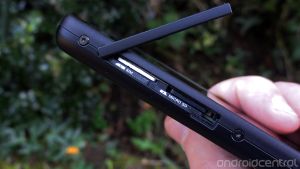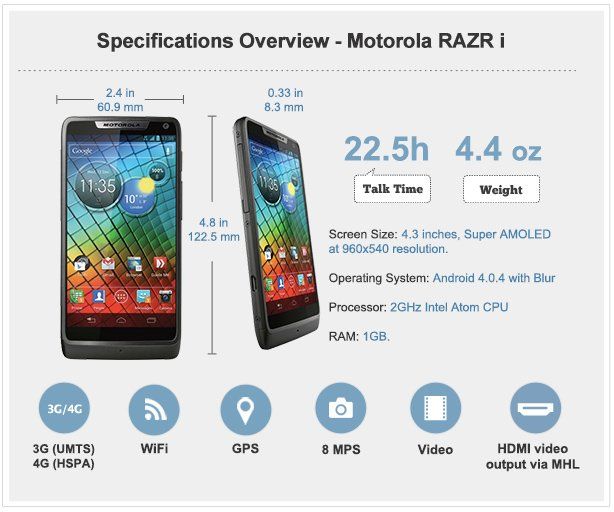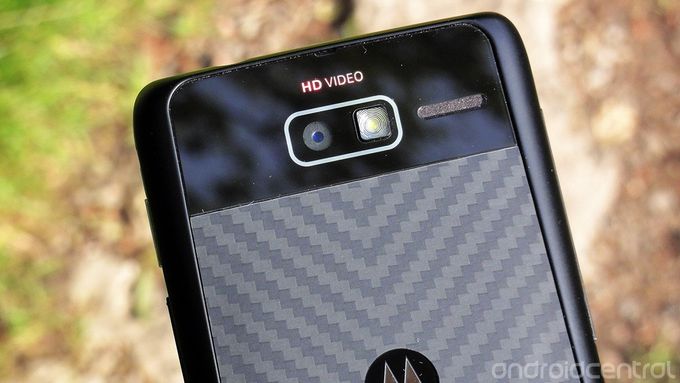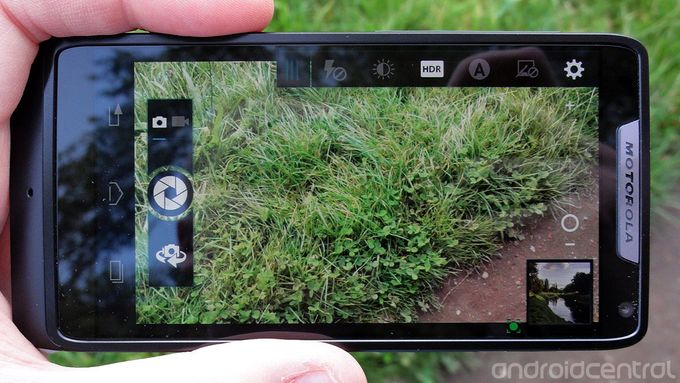
The Intel-Motorola partnership has been a long time coming. The two officially hooked up at CES 2012, where they committed to a “multi-year, multi-device agreement” to bring Intel-powered Moto phones to market. Ten months and a few leaks later, the first such device, the Motorola RAZR i, reaches European store shelves. It may not have been the bleeding-edge, multi-core, 4G behemoth that some — including us — were hoping for, but the RAZR i is nevertheless an important device for both companies. For Moto, it’s a chance to tackle the less hotly-contested mid-range phone market, and differentiate itself through its unique Intel internals. And it’s Intel’s first major Android smartphone from a top-tier manufacturer — an important milestone for the chip giant in its ongoing war against the ever-present ARM.
But all this talk of important firsts and key partnerships means nothing if the device itself isn’t up to snuff. So just how does the Motorola RAZR i shape up in the crowded and fiercely competitive smartphone marketplace of late 2012? Read on to find out.
|
The RAZR i is a speedy, well-featured handset from Motorola, and it does a great job of showcasing the power of Intel on Android. Camera performance is impressive for a mid-range handset. |
Ho-hum industrial design, last-generation screen tech. Compatibility issues in a handful of applications. Launches with ICS as others are preparing to jump to Jelly Bean. |
|
There’s nothing terribly wrong with the RAZR i, and on the whole, we like the direction Moto and Intel are moving in. They’ve delivered a fast performer with a couple of outstanding features, and they deserve credit for that. But does the RAZR i have what it takes to survive the firestorm of competing smartphones coming this October? We’re just not sure. |
|
|
|
Motorola RAZR i video review
Motorola RAZR i hardware review
Motorola’s flagship smartphones have historically exuded an industrial look and feel, with dark colors, cold metals and sharp lines. The RAZR i is an evolution of this style of industrial design. It’s less bulky than earlier Moto phones, with a significantly reduced bezel, though it isn’t quite as ridiculously thin as original RAZR, its girth being roughly comparable to the RAZR MAXX. If you’re familiar with Verizon’s Droid RAZR M, we’re dealing with the same design here.
It’s not the most elegant-looking phone you’ll ever come across. There are plenty of flat edges, exposed torx screws and joining lines. Surrounding the 4.3-inch screen is an aluminum trim, and Moto’s made a big deal out of the RAZR i’s “edge-to-edge” display. It’s true that there’s no unnecessary flab on either side of the phone’s screen, but there’s plenty of superfluous bezel to be found directly beneath the screen. See, as the RAZR i uses the same chassis design as the RAZR M, but without any carrier branding, the space where you’d normally find the Verizon logo is left blank.
Further below, there’s a plastic “chin” which tapers off towards the bottom, and houses the phone’s main microphone, and presumably a bundle of antennae. The main shell of the phone is constructed of matte plastic, which closely matches the appearance of the aluminum trim around the screen. Up top, an etched metal badge proudly displays the Motorola logo.


Around the back, the glossy front of the camera assembly contrasts with the trademark kevlar area dominating most of the rear of the phone. Printed onto that is the “Intel Inside” logo. Along the chassis’ edge, where aluminum and plastic meet, is where the RAZR i’s buttons and ports are located. On the left edge is the standard microUSB port (no HDMI-out this time around), in addition to microSIM and microSD card slots — we used a class 10 32GB card during testing, but no card is provided with the phone. Up top is the 3.5mm headphone jack.
The right edge is home to power, volume and dedicated camera buttons, with the latter being a key marketing point for Intel and Motorola. Hold it down for a second or so when the phone’s locked, and it launches straight into the camera app. A single tap of the camera key when the phone’s awake sparks an even more instantaneous jump into camera mode. The key can also be used as a shutter button, though it’s not a two-stage shutter like some other cameraphones. Helpfully, the camera key is recessed a little, and lies flush with the side of the chassis, in order to prevent accidental presses.
Motorola also says the RAZR i comes with splash protection, meaning it’s not quite fully waterproof, but a should be able to stand up to a little rain during day-to-day use. Though you may be reluctant, as we were, to test the limits of this feature on your own RAZR i.
So on the whole the RAZR i sports a relatively plain, quintessentially Motorolan build and look. If you weren’t a fan of earlier Moto designs, there’s not much here to change your mind. On the other hand, it’s solidly-built, and may be able to stand up to more wear and tear than sleeker, prettier handsets.


But it’s the internals of the RAZR i that really set it apart from every other Android phone out there. It’s powered by a 2GHz Intel Atom Z2480 CPU with Hyperthreading technology. This allows two logical cores to be run on a single hardware core, appearing to the OS as if they were two cores, not one. Hyperthreading is used in many of Intel’s PC chips, and can improve multitasking performance, as well as the performance of multi-threaded apps.
Backing up that CPU is 1GB of RAM and 6GB of internal storage, though as we mentioned earlier that’s expandable via microSD card. (When you insert an SD card, a handy utility allows you to offload multimedia content to your new card.)
Camera-wise, the RAZR i rocks an 8MP rear shooter with LED flash, along with a basic 0.3MP front-facer. We’ll get to a more detailed breakdown of the RAZR i’s camera later in this review, but to make a rough approximation, we’d say the main camera is about Galaxy S2 or Galaxy Note-level.
The phone’s display is a qHD (960×540) SuperAMOLED panel, which on paper is the same as the original RAZR’s screen. In reality, though, there are some substantial differences. The RAZR i is brighter, with much less discoloration to whites, particularly at low brightness levels. Colors are extremely vivid, more so than some higher-resolution SuperAMOLED devices like the Galaxy Nexus. That said, it’s still a PenTile panel at qHD resolution, and that means you’re going to notice some artifacting around text and certain other on-screen elements — that’s just a limitation of this display technology.

Motorola RAZR i battery life
The Motorola RAZR i includes a 2000mAh internal, non-removable battery. That’s larger than average for a device that’s not super-high-end, and as such, we got above average battery life from our RAZR i. Motorola claims around 20 hours of “mixed usage” in its promotional materials, and that lines up with our own experiences using the RAZR i for the past week, both indoors and outdoors, on Wifi and HSPA+ networks. We had no trouble getting through the working day with plenty of juice to spare.
With extremely heavy usage consisting of lot of web browsing, gaming, music and video playback and camera use, and extensive mobile data use over HSPA+, we were able to kill the RAZR i in around seven to eight hours. That’s about average for an Android smartphone of this kind.
We should also note that our RAZR i was running pre-release firmware during our testing, so battery performance may improve somewhat when the device is officially launched in the next month or so. We’ll update this review if we notice any major changes.


Motorola RAZR i specs

Motorola RAZR i software review
The RAZR i runs Android 4.0 Ice Cream Sandwich with some additional sprinkles from Motorola. Unfortunately, there’s no Jelly Bean to be found here, as Intel has only just finished optimizing Android 4.1 for its Atom chips. Motorola has promised to update the RAZR i to Jelly Bean, but it wasn’t willing to commit to any timeframe at the recent London launch event.
What you have on the RAZR i is very close to stock Android — Motorola hasn’t strayed too far from the designs of Matias Duarte and his team at Google. For example, you’ve got the persistent search bar at the top of the home screen, and on-screen buttons down below.




Moto’s software changes are mostly functional, not visual. Smart Actions from the earlier RAZR phones make a comeback, and are useful as ever. Similar to the popular Tasker app, Smart Actions allows you to change certain settings or perform certain tasks based on pre-set conditions. For example, if you’re at home, at night, with your phone charging you can set the device to silence all notifications until morning. Similarly, if the battery is low, you can turn off background data and dim the screen in order to preserve battery life.
There’s also a built-in interactive guide to help out first-time Android users.
And really, that’s about it. The only other changes from vanilla Android are in the Motorola home screen setup. Scroll all the way to the left, and you get a quick settings page. Scroll all the way to the right, and you get the option to add another home screen. A third “favorites” tab has been added to the app drawer, allowing you to select favorite apps from a list and have them appear there for easy access. That might be useful on a carrier-branded phone loaded with bloatware, but our unlocked RAZR i came with no unwanted apps. Motorola’s “circles” widget comes pre-loaded on the RAZR i, showing the time, date, weather and battery level in detail. We’ve seen this before on phones like the Atrix HD — circles can be flipped over to reveal more information. We did notice that this widget was the cause of some occasional homescreen lag, however. Once we removed it, the UI was buttery smooth.
Interestingly, some Jelly Bean launcher enhancements have also made it across, including the ability to bump widgets and icons around to make space on a crowded home screen.




The RAZR i is a quick performer, and provides a great showcase for what can be accomplished with Android on an Intel chip. With the exception of the Motorola widget-induced homescreen lag, the phone was flawlessly smooth. Side-by-side with a Galaxy Nexus running Jelly Bean, the RAZR i consistently provided faster app start-up times, and Intel’s Atom-optimized stock browser also proved faster in Javascript tests. The RAZR i’s gaming performance in apps like Osmos, Angry Birds, Grand Theft Auto III and World of Goo was flawless, though we did come across some compatibility issues caused by the use of an Intel chip.
Google Chrome downloaded, but failed to install, displaying an error message (Motorola says an Intel-friendly Chrome update is coming). Sonic 4 Episode 2 installed, but crashed at startup. Similarly, the BBC Media Player app refused to work on our RAZR i. Those were the only compatibility issues we came across, and we downloaded a fair few apps during our review process. Undoubtedly there’ll be some teething issues as app developers get to grips with Android on Intel, especially in high-performance apps like games.

Motorola RAZR i camera review
The RAZR i includes an 8MP rear camera capable of 1080p video recording, in addition to an 0.3MP front-facing camera. We’ll get the front-facer out of the way to begin with — as the numbers would suggest, it’s a very basic image sensor, and you probably won’t want to use it for anything beyond the occasional Skype call.
The rear camera, however, is a different matter. It doesn’t include a BSI (backside illuminated) sensor, so low-light shots are far from ideal, however we were consistently impressed with the quality of outdoor shots produced by the RAZR i. As Intel and Motorola boasted during their London launch event, camera start-up is instantaneous, as are image capture speeds. Interestingly, we experienced none of the autofocus and shutter speed woes that we noticed on the RAZR i’s 4G cousin, the Droid RAZR M.
Dynamic range isn’t the greatest we’ve come across in a smartphone camera, though the camera app can detect when this may an issue, and when it does, it prompts you to enable HDR mode. We’re accustomed HDR shots on other cameras being something of a crapshoot at the best of times, but we were thoroughly impressed by the HDR camera on the RAZR i. It produced natural-looking shots with plenty of fine detail and no ghosting, even in scenes with movement. It’s also incredibly forgiving of any movement while taking shots. Some darker scenes succumb to a little more visible noise in HDR mode, but that’s a symptom of the way the technology works.

In addition, the camera app includes a burst shot mode capable of taking around 10 shots per second. there are also a few presets for night shots and landscapes, as well as basic filters like black and white and sepia. Panorama mode, however, is conspicuously absent.
The RAZR i also performed video recording duties admirably, matching the output of more expensive handsets. At 1080p resolution, the phone managed a flawless 30 frames per second, with sharp images, quick focussing and smooth transitions between light and dark areas. Check out our sample images and video to see for yourself.
















Motorola RAZR i hackability
Motorola said it’s committed to delivering an unlockable bootloader on the RAZR i where market conditions and carriers allow it. What that means is if you have an unlocked SIM-free RAZR i, you’re probably good to unlock it; if yours is a carrier-branded model, you might want to double-check first.
An unlockable bootloader is a good start, but it may take custom ROM makers a while to get to grips with developing for Android on the Intel architecture. That may present an extra hurdle to overcome before AOSP-based ROMs can be ported over to the RAZR i. We’ll just have to wait and see.


Motorola RAZR i review wrap-up
The RAZR i is a speedy, well-featured handset from Motorola, and it does a great job of showcasing the power of Intel on Android. What it is not, however, is exciting. From the ho-hum industrial design to the last-generation screen tech, it isn’t immediately obvious why this phone is special. You need to be a bit of a nerd to appreciate what makes the RAZR i unique, and even then, user-facing differences between Android on Intel and ARM chips are subtle at best.
The most significant obstacles facing the RAZR i are price and mindshare. Pre-order prices are coming in around £330, a little more than prettier, better-known, Snapdragon-powered HTC One S. The RAZR i is a decent handset, but it needs to be cheaper than this if it’s going to succeed. Perhaps on-contract prices from carriers will be more favorable.
Moto also doesn’t have the best track record with software updates, and with Samsung and HTC’s Jelly Bean updates likely to arrive around the same time the RAZR i releases with ICS, that’s another mark in favor of the competition. Then there’s the fact that certain apps, including some games and even Google Chrome, don’t yet work on Intel chips.
There’s nothing terribly wrong with the RAZR i, and on the whole, we like the direction Moto and Intel are moving in. They’ve delivered a fast performer with a couple of outstanding features, and they deserve credit for that. But does the RAZR i have what it takes to survive the firestorm of competing smartphones coming this October? We’re just not sure.
